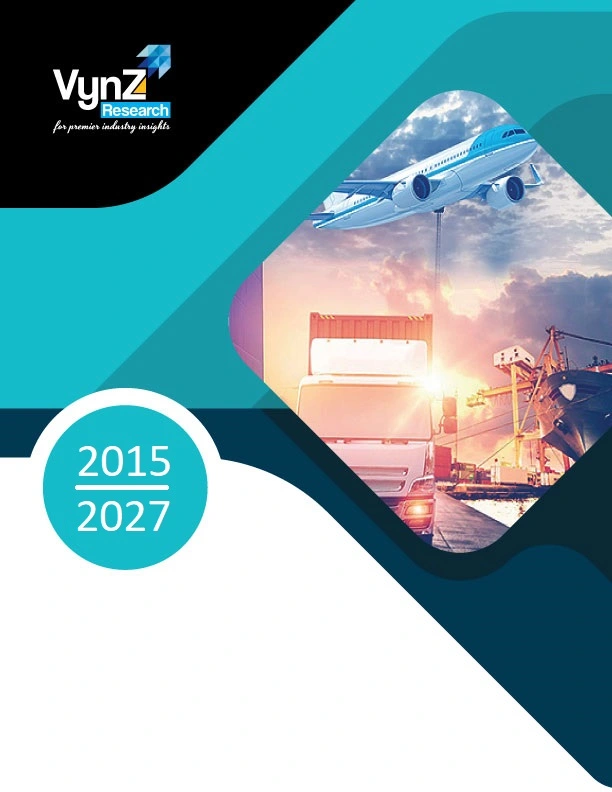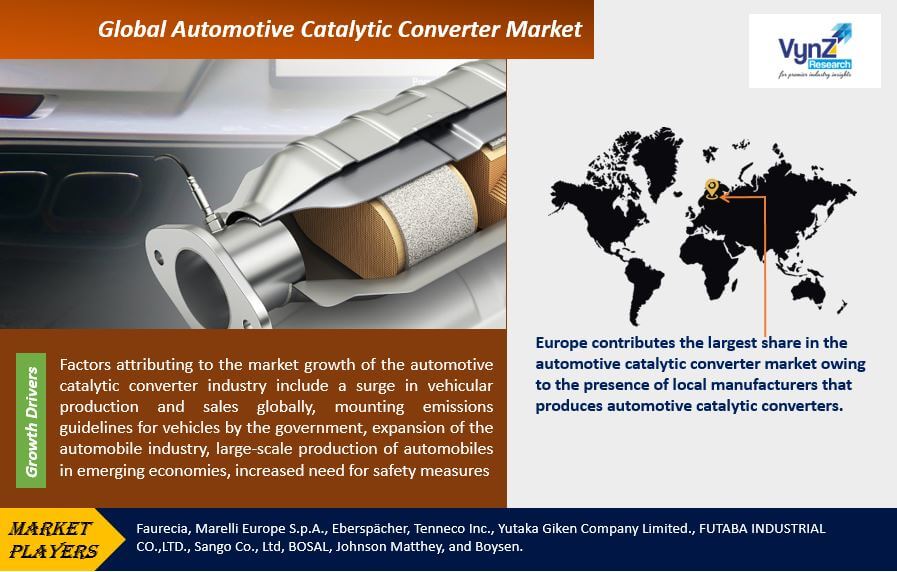| Status : Published | Published On : Apr, 2024 | Report Code : VRAT9624 | Industry : Automotive & Transportation | Available Format :

|
Page : 200 |

Global Automotive Catalytic Converter Market – Analysis and Forecast (2025-2030)
Industry Insight by Material (Palladium, Platinum, Rhodium, and Others), by Product (Four-Way Catalytic Converter, Three-Way Oxidation-Reduction Catalytic Converter, Two-Way Oxidation Catalytic Converter, and Diesel Oxidation Catalyst), by Vehicle Type (Light Commercial Vehicles, Heavy Commercial Vehicles, and Passenger Cars), and Geography (U.S., Canada, Germany, U.K., France, China, Japan, India, and Rest of the World)
Industry Overview
The Global Automotive Catalytic Converter Market size is expected to grow from USD 46.4 billion in 2023 to USD 83.1 billion by 2030. It will register a CAGR of 8.8% during the forecast period. Automatic catalytic converter minimizes emissions in automobiles as it removes toxic compounds like nitrogen oxide, hydrocarbon, and carbon monoxide from the exhaust system of vehicles. Two-way oxidation converters, three-way oxidation converters, and diesel oxidation catalysts are various types of catalytic converters. These systems control the emission by catalyzing toxic gases into non-toxic gases via a redox reaction. Toxic gases like carbon monoxide, nitrogen oxide, and hydrocarbons are converted into water vapor, nitrogen, and carbon dioxide via chemical reactions. Furthermore, they aid in enhancing the efficiency of vehicles. Nevertheless, automobile manufacturing companies are complying with regulatory norms, offering cost-effective solutions, and enhancing vehicle performance, thereby bolstering the market development of the global automotive catalytic converter industry.

Automotive Catalytic Converter Market Segmentation
Insight by Material
Based on Material, the Global Automotive Catalytic Converter Market is classified into Palladium, Platinum, Rhodium, and Others. The rhodium segment is expected to witness the largest share in the global automotive catalytic converter market owing to a surge in demand for rhodium in several applications such as electrical & electronics, catalysts, and chemical manufacturing as it has the property to emit less hazardous gases. Rhodium and platinum act as reduction catalyst in the first catalyst stage as it releases oxygen from nitrogen oxide. Furthermore, rhodium is an extensively used material in automotive catalytic converter recycling as it offers high efficiency by eliminating toxic exhaust emissions and breaking down exhaust gases.
Insight by Product
Based on Product, the Global Automotive Catalytic Converter Market is divided into Four-Way Catalytic Converters (FWCC), Three-Way Oxidation-Reduction Catalytic Converter (TWCC), Two-Way Oxidation Catalytic Converter, and Diesel Oxidation Catalyst. The Three-Way Oxidation-Reduction Catalytic Converter (TWCC) contributes the largest share in the market owing to the surge in market demand for gasoline vehicles and they provide better emission reduction. The market growth in the category is mostly attributable to their improved effectiveness and quick response to hydrocarbon pollutants, nitrogen oxides, and carbon monoxide.
The Diesel Oxidation Catalyst is anticipated to have a high CAGR during the forecast period owing to the widespread use of these converters in on-road and off-road diesel vehicles, mainly construction and agricultural machines. Thus, the market will be driven by the rising need for goods transportation, which will spur the sale of diesel trucks and other logistical vehicles.
Insight by Vehicle Type
Based on Vehicle Type, the Global Automotive Catalytic Converter Market is segmented into Light Commercial Vehicles, Heavy Commercial Vehicles, and Passenger Cars. Passenger cars contribute the largest share in the global automotive catalytic converter market owing to economic growth globally and rising disposable income among consumers.
Global Automotive Catalytic Converter Market Report Coverage
|
Report Metric |
Details |
|
Historical Period |
2018 - 2023 |
|
Base Year Considered |
2024 |
|
Forecast Period |
2025 - 2030 |
|
Market Size in 2024 |
U.S.D. 46.4 Billion |
|
Revenue Forecast in 2030 |
U.S.D. 83.1 Billion |
|
Growth Rate |
8.8% |
|
Segments Covered in the Report |
By Material, By Product, By Vehicle Type |
|
Report Scope |
Market Trends, Drivers, and Restraints; Revenue Estimation and Forecast; Segmentation Analysis; Impact of COVID-19; Companies’ Strategic Developments; Market Share Analysis of Key Players; Company Profiling |
|
Regions Covered in the Report |
North America, Europe, Asia-Pacific (APAC) and Rest of the World (RoW) |
Industry Dynamics
Automotive Catalytic Converter Market Growth Drivers
Factors attributing to the market growth of the automotive catalytic converter industry include a surge in vehicular production and sales globally, mounting emissions guidelines for vehicles by the government, expansion of the automobile industry, large-scale production of automobiles in emerging economies, increased need for safety measures
The production of economical and low-emission catalytic converters for the exhaust system, along with large R&D expenditures, is anticipated to drive the market value upward. This is due to the significant emphasis by vehicle OEMs. Additionally, throughout the projection period, the global market will benefit from rising population demand for performance aftermarket automotive components, particularly for internal combustion engines.
Furthermore, catalytic converters offer properties like improved energy efficacy, operational efficacy, and safety measures, thereby bolstering the market development of the global automotive catalytic converter industry. Nevertheless, the extensive research and development efforts undertaken by automakers to reduce the impact of the dangerous gases they produce may also be related to the growth of the market.
Automotive Catalytic Converter Market Challenges
The surge in prices of precious group metals, resulting in high costs along with rising demand for electric and hybrid vehicles that produce minimal exhaust emissions and do not need installation of such catalytic converters will hinder the market size of the global automotive catalytic converter industry. An electric motor, rather than an internal combustion engine, produces power in an electric vehicle since it lacks a combustion chamber. Consequently, a catalytic converter is not needed.
Automotive Catalytic Converter Market Opportunities
The key players anticipate an increase in automotive catalytic converter market share, creating market opportunities in the global market as a result of:
- The rising demand for fuel-efficient cars
- Development in material technology
- Development of Nanotechnology
Automotive Catalytic Converter Market Geographic Overview
- North America
- Europe
- Asia Pacific (APAC)
- Rest of the World (RoW)
Europe contributes the largest share in the automotive catalytic converter market owing to the presence of local manufacturers that produce automotive catalytic converters. Furthermore, the rising demand for high-end vehicles, the rising number of auto part product facilities, strict emission norms like Euro V and Euro VI, and increased R&D expenditure will proliferate the growth in the region.
Automotive Catalytic Converter Market Competitive Insight
Manufacturers in the automotive catalytic converter market are implementing inventory management tactics by forming partnerships through backward incorporation with the raw material suppliers to address the volatile costs of raw materials. Automotive catalytic converter market participants, like e-commerce merchants, are using cutting-edge distribution techniques by providing online catalogs rather than delivering directly to automakers. Thus, the leading players are currently concentrating on implementing strategies like product innovations, mergers and acquisitions, joint ventures, collaborations, and partnerships to strengthen their market position in the worldwide automotive catalytic converter market.
The automotive sector anticipates a large decrease in the exhaust gas limit values for HC, CO, NOx, and other pollutants as a result of the new EURO 7 emission standard. Eberspaecher is moving ahead with ideas to further minimize pollution emissions with its Active Heating product range. The exhaust specialist closely collaborates with clients to get a variety of solutions suitable for mass production. It takes the OEM's specifications, the geometry of the vehicle, and the installation area into careful consideration while doing this. The first step involves the specialists taking advantage of the chance to cut emissions during the cold-start phase. The EHC Lamella Heater, if necessary, warms the exhaust gas purification system even before the engine is started, boosting exhaust gas purification effectiveness right from the start of the process.
Tenneco Automotive is a global manufacturer and marketer of ride control and exhaust systems and products sold under the brands Monroe® and Walker®. Tenneco advances global mobility by delivering technology solutions to diverse global markets through their four business groups, Motorparts, Performance Solutions, Clean Air, and Powertrain. Sensa-Trac® and ReflexTM shocks and struts, Rancho® shock absorbers, Walker® Quiet-FlowTM mufflers and DynoMaxTM performance exhaust products, and Monroe® CleviteTM vibration control components are among its offerings.
Recent Development by Key Players
To supply the Battery Thermal Plate (BTP) for future Battery Electric Vehicles (BEVs), Marelli has been awarded a significant contract from a major global carmaker. Marelli shall produce in-house, the solution, a key technology for thermal energy management in electric vehicles.
Johnson Matthey (JM) and thyssenkrupp Uhde collaborated to develop a fully integrated blue ammonia solution by combining their own respective technologies.
Key Players Covered in the Report
Some of the major players operating in the global automotive catalyst converter market include Faurecia, Marelli Europe S.p.A., Eberspächer, Tenneco Inc., Yutaka Giken Company Limited., FUTABA INDUSTRIAL CO., LTD., Sango Co., Ltd, BOSAL, Johnson Matthey, and Boysen.
The Automotive Catalytic Converter Market report offers a comprehensive market segmentation analysis along with an estimation for the forecast period 2025–2030.
Segments Covered in the Report
- By Material
- Palladium
- Platinum
- Rhodium
- Others
- By Product
- Four Way Catalytic Converter (FWCC)
- Three Way Oxidation Reduction Catalytic Converter (TWCC)
- Two Way Oxidation Catalytic Converter
- Diesel Oxidation Catalyst
- By Vehicle Type
- Passenger Cars
- Light Commercial Vehicles
- Heavy Commercial Vehicles
Geographical Segmentation
- North America
- U.S.
- Canada
- Mexico
- Europe
- Germany
- U.K.
- France
- Italy
- Spain
- Russia
- Rest of Europe
- Asia-Pacific (APAC)
- China
- Japan
- India
- South Korea
- Rest of Asia-Pacific
- Rest of the World (RoW)
- Brazil
- Saudi Arabia
- South Africa
- U.A.E.
- Other Countries
.png)
To explore more about this report - Request a free sample copy
Frequently Asked Questions
Purchase Options
Latest Report
Research Methodology
- Desk Research / Pilot Interviews
- Build Market Size Model
- Research and Analysis
- Final Deliverabvle
Connect With Our Sales Team
- Toll-Free: 1 888 253 3960
- Phone: +91 9960 288 381
- Email: enquiry@vynzresearch.com
Automotive Catalytic Converter Market
